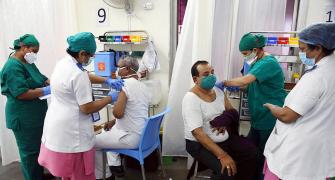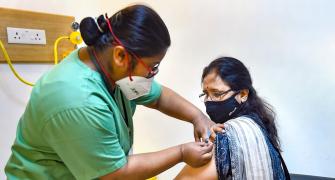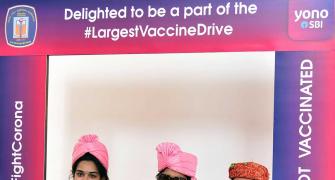The Centre wrote to Maharashtra, Punjab and Delhi governments on Wednesday flagging below-par vaccination of eligible beneficiaries, including healthcare workers.

In a letter to the principal secretaries of Punjab, Delhi and Maharashtra, Additional Health Secretary Manohar Agnani noted that the performance of these states and UT have been below the national average and needs improvement.
Agnani's letter comes after a strongly worded statement issued by Union Health Minister Harsh Vardhan in which he hit out at Maharashtra and some other states, accusing them of trying to cover their 'failures' and spreading panic among people by demanding vaccination of all without inoculating enough of eligible beneficiaries.
Maharashtra, Punjab and Delhi were urged to undertake necessary corrective actions immediately towards improving the performance of COVID-19 vaccination drive in their states and union territory.
"I look forward to your unstinted support for the ongoing COVID-19 vaccination drive which is critical to mitigate the impact of COVID-19 pandemic," he said.
In the letter to Maharashtra, Agnani said a total of 1,06,19,190 doses have been made available to the state/UT and the total consumption, including wastage, is 90,53,523 doses.
Agnani said a detailed analysis of performance of COVID-19 vaccination drive reveals that till 7 pm on April 7, as per COWIN Portal, 85.95 per cent (national average 85.8 per cent) of registered healthcare workers have been vaccinated with first dose of COVID-19 vaccine.
The second dose coverage amongst registered HCW, is 41.08 per cent (national average 51.49 per cent).
'This is below the national average and needs improvement,' he said.
Moreover, a similar analysis for registered frontline workers, indicates first dose coverage of 71.37 per cent (national average 71.1 per cent) and second dose coverage of 22.39 per cent (national average 29.97 per cent) amongst registered FLWs.
'Farther, the coverage amongst the population aged 45 years and above stands at 16.67 per cent (national average 16.71 per cent),' Agnani said, calling for improvement in vaccination coverage.
For Delhi, Agnani said a total of 23,70,710 doses have been made available and the total consumption, including wastage, is 18,70,662 doses.
A detailed analysis of performance of vaccination drive reveals that till April 7 at 7 pm, as per COWIN Portal, 71.69 per cent (national average 85.8 per cent) of registered HCWs have been vaccinated with the first dose of COVID-19 vaccine.
This is below the national average and needs improvement. The second dose coverage amongst registered healthcare workers is 41.48 per cent (national average 51.49 per cent). This is also below the national average and needs improvement, he said.
He said a similar analysis for registered frontline workers, indicate first dose coverage of 73.24 per cent (national average 71.1 per cent ) and second dose coverage of 40.98 per cent (national average 29.97 per cent) amongst registered FLWs.
'Further, the coverage amongst population aged 45 years and above stands at 18.66 per cent (national average 16.71 per cent),' Agnani said, calling for improvement in the level of coverage.
In the letter to Punjab, Agnani said a total of 22,36,770 doses have been made available to the state/UT and the total consumption, including wastage, is 14,94,663 doses.
A detailed analysis of performance of COVID-19 vaccination drive reveals that till April 7, 63.95 per cent (national average 85.8 per cent) of registered HCWs have been vaccinated with the first dose of vaccine.
'This is below the national average and needs improvement. The second dose coverage amongst registered HCW is only 27.36 per cent (national average 51.49 per cent). This is also below the national average and needs improvement,' he said.
A similar analysis for registered frontline workers, indicates first dose coverage of 64.68 per cent (national average 71.1 per cent) and second dose coverage of only 19.57 per cent (national average 29.97 per cent ) amongst registered FLWs.
Further, the coverage amongst the population aged 45 years and above stands at mere 11.08 per cent (national average 16.71 per cent).
'This brings out the need for stepped efforts by the state/UT administration to improve the level of coverage of the first as well as the second dose among the HCWs and FLWs, as the primary objective of the vaccination is to protect the healthcare and pandemic response system, especially in the states having surge in cases,' he said.
In addition, HCWs and FLWs represents well-defined beneficiary group and therefore must be covered expeditiously, he added.










